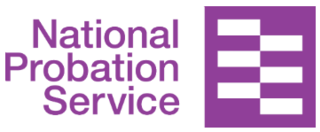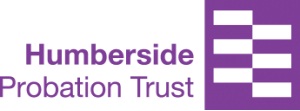
The Youth Criminal Justice Act is a Canadian statute, which came into effect on April 1, 2003. It covers the prosecution of youths for criminal offences. The Act replaced the Young Offenders Act, which itself was a replacement for the Juvenile Delinquents Act.
Probation in criminal law is a period of supervision over an offender, ordered by the court often in lieu of incarceration.
OASys is the abbreviated term for the Offender Assessment System, used in England and Wales by His Majesty's Prison Service and the National Probation Service to measure the risks and needs of criminal offenders under their supervision. Initially developed in 2001, it was built upon the existing ‘What Works’ evidence base.

The Probation Service for England and Wales is a statutory criminal justice service, mainly responsible for the supervision of offenders in the community and the provision of reports to the criminal courts to assist them in their sentencing duties. It was established in its current form by the Criminal Justice and Court Services Act in April 2001, but has existed since 1907 as a set of area-based services interacting at arm's length with central government.
A suspended sentence is a sentence on conviction for a criminal offence, the serving of which the court orders to be deferred in order to allow the defendant to perform a period of probation. If the defendant does not break the law during that period and fulfills the particular conditions of the probation, the sentence is usually considered fulfilled. If the defendant commits another offence or breaks the terms of probation, the court can order the sentence to be served, in addition to any sentence for the new offence.

In England and Wales, a youth offending team (YOT) is a multi-agency team that is coordinated by a local authority and overseen by the Youth Justice Board. It deals with young offenders, sets up community services and reparation plans, and attempts to prevent youth recidivism and incarceration. YOTs were set up following the 1998 Crime and Disorder Act with the intention of reducing the risk of young people offending and re-offending, and to provide counsel and rehabilitation to those who do offend. Youth offending teams engage in a wide variety of work with young offenders in order to achieve their aims. YOTs supervise young people who have been ordered by the court to serve sentences in the community or in the secure estate. Sometimes, teams organise meetings between offenders and victims to encourage apologies and reparation.

A probation or parole officer is an official appointed or sworn to investigate, report on, and supervise the conduct of convicted offenders on probation or those released from incarceration to community supervision such as parole. Most probation and parole officers are employed by the government of the jurisdiction in which they operate, although some are employed by private companies that provide contracted services to the government.
ACT Corrective Services (ACTCS) is an agency of the Justice and Community Safety Directorate (JACSD) of the Australian Capital Territory government in the Australian Capital Territory, Australia. It is responsible for a wide range of activities and services in the area aimed at protecting the community and reducing offending behaviour.
In the jurisdiction of England and Wales, a Multi-Agency Public Protection Arrangement (MAPPA) is an arrangement, set up in 2001, for the "responsible authorities" tasked with the management of registered sex offenders, violent and other types of sexual offenders, and offenders who pose a serious risk of harm to the public. The "responsible authorities" of the MAPPA include the National Probation Service, HM Prison Service and England and Wales Police Forces. MAPPA is coordinated and supported nationally by the Public Protection Unit within the National Offender Management Service. MAPPA was introduced by the Criminal Justice and Court Services Act 2000 and was strengthened under the Criminal Justice Act 2003.
Community sentence or alternative sentencing or non-custodial sentence is a collective name in criminal justice for all the different ways in which courts can punish a defendant who has been convicted of committing an offense, other than through a custodial sentence or capital punishment (death).
The youth justice system in England and Wales comprises the organs and processes that are used to prosecute, convict and punish persons under 18 years of age who commit criminal offences. The principal aim of the youth justice system is to prevent offending by children and young persons.

The Parole Board for England and Wales was established in 1968 under the Criminal Justice Act 1967. It became an independent executive non-departmental public body (NDPB) on 1 July 1996 under the Criminal Justice and Public Order Act 1994. The Parole Board is governed by the Parole Board Rules 2016 made by Parliament under the Criminal Justice Act 2003. Parole Board members are appointed by the Secretary of State for Justice, but are required to take judicial decisions independent of Government.

Crime in New Zealand encompasses criminal law, crime statistics, the nature and characteristics of crime, sentencing, punishment, and public perceptions of crime. New Zealand criminal law has its origins in English criminal law, which was codified into statute by the New Zealand parliament in 1893. Although New Zealand remains a common law jurisdiction, all criminal offences and their penalties are codified in New Zealand statutes.
A rehabilitation policy within criminology, is one intending to reform criminals rather than punish them and/or segregate them from the greater community.
Sentencing in England and Wales refers to a bench of magistrates or district judge in a magistrate's court or a judge in the Crown Court passing sentence on a person found guilty of a criminal offence. In deciding the sentence, the court will take into account a number of factors: the type of offence and how serious it is, the timing of any plea of guilty, the defendant's character and antecedents, including their criminal record and the defendant's personal circumstances such as their financial circumstances in the case of a fine being imposed.

Humberside Probation Trust was a criminal justice agency. Humberside was one of 35 probation trusts within England and Wales that were part of the National Offender Management Service (NOMS) and a department of the Ministry of Justice.
The New Zealand Parole Board is an independent statutory body established in 2002 that considers offenders for parole. Its task "is to undertake an assessment of the risk that long-term sentenced offenders might pose to the safety of the community if they were to be released before the end of their sentence". The Board also sets conditions of release for offenders so their reintegration back in to the community can be effectively managed. Once the conditions are set it becomes the responsibility of Community Corrections to manage the offender." 'Long term' is defined as more than 24 months. Short-term prisoners are automatically released after serving half their sentence.
The New Zealand Probation Service is a branch or service of the New Zealand Corrections Department. Established in 1886, its role is to manage offenders sentenced to community based sentences such as home detention, community detention and intensive supervision. The Service also manages prisoners in the community who have been released on parole and offenders on release conditions at the end of their prison sentence. According to Corrections website, in 2014 the Service was looking after approximately 30,000 offenders in the community. The Probation Officer's role is described as "work(ing) with people on probation to motivate them to make changes in their lives. This may include attending programmes to address violence, alcohol and drug abuse or driving offences."
In the Australian legal system, a good behaviour bond is a type of non-custodial sentence which involves the condition of the offender's “good behaviour” for a set period. The condition of “good behaviour” primarily requires the offender to obey the law, but may also include additional probation officer supervision, mandatory medical treatment or participation in rehabilitation, counselling and intervention programs. These imposed conditions are determined by state legislation and at the magistrate's discretion. A good behaviour bond may be established with or without a recorded legal conviction for the offence. The specific conditions which constitute a good behaviour bond, as well as the consequences for breaching them, vary under each Australian state or territory's legislation, but overall are used most commonly for first-time and juvenile offenders.

Lifetime probation is reserved for relatively serious legal offenders. The ultimate purpose of lifetime probation is to examine whether offenders properly maintain good behavior as well as capability of patience under lifetime probation serving circumstance. An offender is required to abide by particular conditions for rest of their entire life in order to nurture superior social behaviour as a punishment for their criminal offence. Condition of probation orders contain supervision, electronic tagging, reporting to his or her probation or parole officer, as well as attending counselling. The essential component of lifetime probation carries the sense of being examined for well-being character and behaviour for life term period. Legislative framework regarding probation may vary depending on the country or the state within a certain country as well as the duration and condition of probational sentencing.







